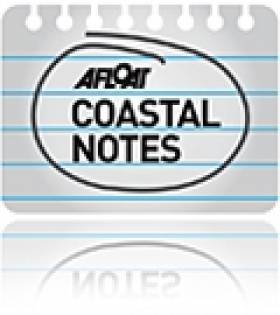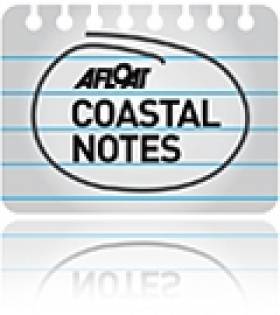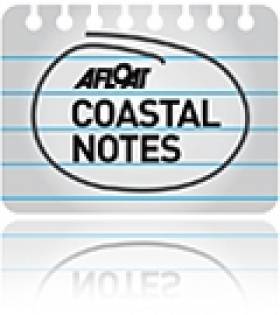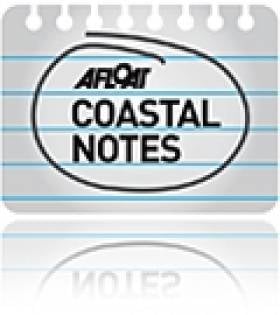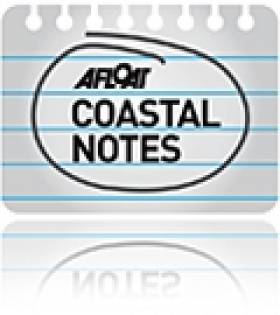Displaying items by tag: Barryroe
Geophysical & Environmental Site Survey Off South Coast
A seabed debris clearance, environmental baseline and habitat assessment site survey will take place in licence SEL 1/11 (Barryroe) from later this month.
Barryroe is located in the North Celtic Sea, some 50 kilometres south of the Port of Cork.
The project is scheduled to commence in mid-August 2019 with the survey vessel Kommandor (callsign MCJO2) anticipated to be working on location for 16 days, excluding transit and any weather delays
Survey operations will be conducted on a 24-hour basis in different phases to include towed and non-towed operations. A fisheries liaison Officer will be on board for the duration of the survey.
Throughout the survey operations, the vessel will be displaying appropriate shapes and lights to indicate that the survey vessel is restricted in its ability to manoeuvre.
All vessels are requested to give this operation a wide berth. A listening watch will be maintained on VHF Channel 16, and the vessel will actively transmit an AIS signal.
Full details of the site survey co-ordinates are included in Marine Notice No 27 of 2019, a PDF of which is available to read or download HERE.
Reduced Costs Drive Barryroe Oil Field Farm-Out Interest
#Oil&Gas - A drop in exploration costs alongside the fall in commodities prices is driving increased interest in Providence Resources' Barryroe prospect, as The Irish Times reports.
"Work continues with a number of parties to progress the Barryroe farm out to a satisfactory conclusion,” said Tony O’Reilly, chief executive of the Dublin-based oil and gas exploration firm.
It comes more than a year after negotiations over the farm-out of the oil field off Ireland's south coast began, a process that the company said was "taking much longer to achieve" due to unfavourable market conditions.
Studies in 2012 indicated that the Barryroe field could yield as much as 1.6 billion barrels, and be worth many billions to the Irish economy.
The Irish Times has more on the story HERE.
Barryroe 'Main Priority' For Providence As Negotiations Reach 'Advanced Stage'
#Oil - Providence Resources says it is at "an advanced stage" in negotiations to farm out its Barryroe oil field prospect off Cork, as The Irish Times reports.
Commenting on the Irish energy company's half-year results released today, CEO Tony O'Reilly said the Barryroe project "remains our main priority" – with Providence aiming to return on its investment while retaining "a material stake" in the field, of which is owns 80%.
Last month, as reported on Afloat.ie, the company urged shareholders at its AGM to quell public speculation over any potential deal, which was "taking much longer to achieve" than previously expected.
The Irish Times has more on the story HERE.
#Oil - Providence Resources says it is "nearing completion" of its negotiations to secure a farm-out partner for its Barryroe prospect off the Cork coast, as The Irish Times reports.
Speaking at the Irish-based oil and gas company's AGM earlier this week, CEO Tony O'Reilly also urged interested parties to hold off on any public speculation over the deal, which chairman Brian Hillery said was "taking much longer to achieve" due to "the current environment".
"It's not a question of getting a deal, it's getting the right deal," he told shareholders. "Rest assured the farm-out remains the main priority of the company."
That wasn't enough to quell some shareholders' displeasure, however, with one taking Providence to task over the drastic fall in its share price over the last 12 months - in part a result of alleged setbacks to the south coast prospect in January.
The Irish Times has much more on the story HERE.
Providence Dismisses Setback Claims Over Barryroe Prospect
#Oil - News that the Barryroe prospect off the south coast requires a new appraisal well at a cost of some €30 million sent shares in Providence Resources tumbling on the Dublin market as trading opened today.
But the Irish oil and gas firm says there has been no setback to its plans for the oil field and "no material change" to its status, as The Irish Times reports.
And the company says it remains in discussions with "major Asian, European and North American oil companies" to tap Barryroe as a collaborative venture that's expected to be worth billions to the Irish economy.
Shares fell 9% this morning following a Sunday Times article that suggested Providence would seek funds from shareholders for new drilling in the Celtic Sea prospect.
Fastnet Oil Takes Option On 'Deep Kinsale Prospect'
#Oil - Fastnet Oil & Gas has executed its exclusive option agreement to farm into its Deep Kinsale Prospect beneath the Kinsale Head Gas Field.
The option agreement with Petronas subsidiary Kinsale Energy is confined to geological formations below 4,000 feet subsea. Fastnet will conduct a 3D seismic survey over 500 sq km in the Celtic Sea prospect by the end of the year as well as complete necessary geological and engineering studies.
The agreement also gives Fastnet an exclusive option to test the geologically similar Purbecko-Wealden reservoirs productive in Barryroe, a prospect that has proven a bounty for Providence Resources.
Fastnet chair Cathal Friel said: "We are delighted to have added an exclusive option to farm into and potentially drill the Deep Kinsale Prospect in 2014.
"It represents an attractive addition to our Irish portfolio as we have long held a belief that Deep Kinsale offers the potential to yield up another significant hydrocarbon discovery offshore Ireland. This belief has been further strengthened by the successful appraisal of Barryroe in 2012, which is geologically analogous to Deep Kinsale.
"We greatly look forward to working in close cooperation with our colleagues at Kinsale Energy, as we collectively seek to de-risk the prospect for drilling."
As previously reported on Afloat.ie, Fastnet Oil & Gas announced in December its plans to spend more than €20 million on the Celtic Sea's biggest ever seismic study on blocks off the south coast which were drilled in the 1980s and later abandoned.
New techniques in the oil industry are now allowing previously unviable resources to be extracted, as fellow prospectors Petrel Resources are planning to do off the Kerry coast.
Fastnet Oil Plans Celtic Sea's Biggest Seismic Survey
#OIL - Fastnet Oil & Gas will spend more than €20 million on the Celtic Sea's biggest ever seismic study, the Irish Independent reports.
The company was recently awarded two blocks in the waters south of Ireland which were drilled in the 1980s and subsequently abandoned.
But new techniques in the oil industry are allowing previously unviable resources to be extracted - as Petrel Resources are planning to do off the Kerry coast, following the discovery of enormous oil reserves in the Porcupine Basin.
And the Celtic Sea in particular has already attracted attention after Providence Resources announced its discovery of oil reserves at its Barryroe prospect potentially worth billions of euros.
Fastnet Oil, chaired by Cathal Friel, is currently in discussions with major oil groups with a view to sharing the costs of the seismic survey.
New Targets for Oil Exploration Off Southwest Coast
#COASTAL NOTES - Oil exploration company Petrel Resources has identified a number of new targets off the southwest coast of Ireland as it seeks bigger partners for its venture.
The Irish Times reports that the Dublin-based firm was awarded licensing options over 1,400 sq km of the Porcupine Basin or Porcupine Blight in the Atlantic Ocean, west of Dursey Island in Co Kerry.
It has since completed two phases of work in the area, and says technical studies of its blocks in the northern and eastern parts of the basin, where is is testing for the presence of reservoir sands, were "encouraging".
The announcement comes following the success of Providence Resources' prospect in the Celtic Sea off the south coast.
As previously reported on Afloat.ie, the Barryroe field may deliver in excess of 2 billion barrels of oil, a flow expected to be worth billions of euro to the Irish economy in future years.
The Irish Times has more on the story HERE.
Barryroe Oil Field May Hold Further Resources Says Study
#COASTAL NOTES - The Barryroe field off the south coast of Cork may deliver even more oil than previously anticipated, according to the latest surveys.
The Irish Times reports that Providence Resources has completed an evaluation of its Celtic Sea prospect which indicates that the Lower Wealden and Purbeckian areas could hold an "encouraging" yield of 778 million barrels.
The oil firm's tectnical director told the paper that the focus would remain on the Middle and Basal Wealden sands following its appraisal wells drilled over the spring and summer.
As previously reported on Afloat.ie, seismic data and results from six test wells on the Barryroe site led experts to estimate that the oil field contains as much as 1.6 billion barrels in total - four times as much as previous projections.
The oil flow is expected to be worth billions of euro to the Irish economy over a number of years.
The latest news "further reinforces the prospectivity of the area" according to Davy Stockbrokers, who added that "it also suggests that Barryroe will not be the only development of Purbeckian oil in the Celtic Sea".
#COASTAL NOTES - Providence Resourses has announced that its Barryroe oil field off the south coast may be as much as four times larger than anticipated, according to The Irish Times.
Afloat.ie previously reported on the Irish mineral exploration group's discovery in April this year, when the company confirmed the presence of light oil with an appraisal well at the site in the north Celic Sea.
Then on 15 March the firm announced that oil had begun to flow successfully from the Barryroe structure at a rate that could be worth billions of euro to the Irish economy.
The latest news suggests it could be worth even more over a longer period of time, as data compiled from six test wells on the site along with seismic data have led experts to estimate the field contains between 1 and 1.6 billion barrels of oil.
“It is clear that Barryroe is a substantial oil accumulation across multiple stacked horizons with much running room for further resource growth," said Providence chief executive Tony O'Reilly Jr.
The company also expects to begin explorations off Dalkey Island in Co Dublin by the end of the year, pending approval of its foreshore permit.
The so-called 'Dalkey Island prospect' has sparked much debate about its potential risks and benefits among the local community.




























